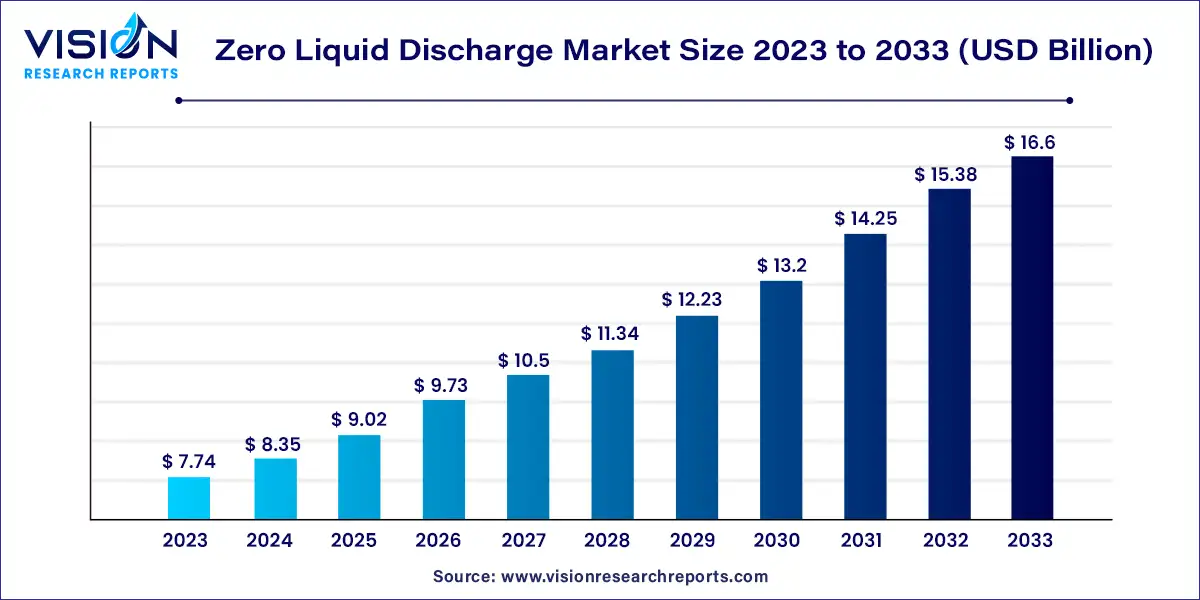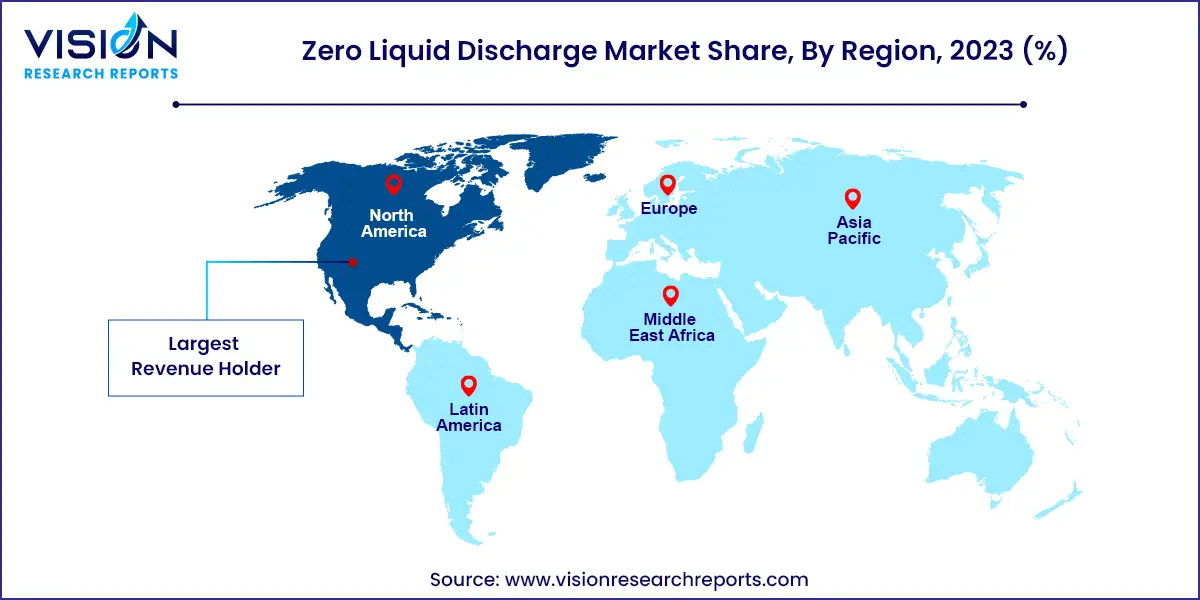The global zero liquid discharge system market size was estimated at around USD 7.74 billion in 2023 and it is projected to hit around USD 16.6 billion by 2033, growing at a CAGR of 7.93% from 2024 to 2033.

The zero liquid discharge (ZLD) system market is experiencing significant growth as industries worldwide prioritize environmental sustainability and regulatory compliance. ZLD systems, which ensure that no liquid waste is discharged from a facility, play a crucial role in water conservation and pollution control.
The growth of the zero liquid discharge (ZLD) system market is driven by the stringent environmental regulations globally compel industries to adopt ZLD systems to minimize wastewater discharge and comply with standards. Increasing water scarcity enhances the appeal of ZLD systems by promoting water conservation and reuse. Technological advancements in membrane filtration, thermal processes, and chemical treatments improve system efficiency and reduce operational costs, making ZLD systems more accessible and attractive to various industries. These factors collectively contribute to the expanding adoption of ZLD systems across different sectors, driving market growth significantly.
The conventional segment held a significant market share in 2023. Conventional zero liquid discharge (ZLD) systems offer several advantages. They enable industries to comply with stringent environmental regulations by effectively eliminating liquid waste discharge. Additionally, ZLD systems recover valuable resources like salts and minerals, which can be reused or sold, potentially creating additional revenue streams. By recycling and reusing treated wastewater, these systems notably reduce freshwater demand, making them particularly suitable for regions facing water scarcity. Moreover, ZLD systems provide long-term cost savings by reducing expenses related to water procurement, treatment, and disposal.
Evaporation/crystallization emerged as the largest segment in 2023. In a ZLD system, this process concentrates liquid waste by first collecting and pretreating wastewater to remove impurities. The treated wastewater undergoes heating, causing water to evaporate and increasing the concentration of dissolved solids. As the solution reaches a critical point, solutes crystallize, aided by cooling, seeding, or additives. The resulting solid crystals are separated from the remaining liquid using techniques such as centrifugation or filtration. These recovered solids hold value and can be reused or sold. The remaining significantly reduced liquid can undergo further treatment or responsible disposal, achieving zero liquid discharge.
The energy and power segment captured a substantial market share in 2023. ZLD systems play a crucial role in this sector by treating and recycling wastewater from power plants, thereby reducing freshwater intake and ensuring compliance with stringent environmental regulations. These systems recover valuable resources from concentrated brine, contributing to additional revenue streams or reuse opportunities. They also significantly reduce water consumption, which is critical in regions with water scarcity, and offer long-term cost savings by lowering expenses related to water procurement and disposal. Furthermore, ZLD systems support sustainability goals, demonstrating responsible water management practices and enhancing industry reputation, while improving the efficiency and longevity of critical equipment.
North America emerged as the largest region in 2023. The U.S. government, at both federal and state levels, has implemented increasingly stringent environmental regulations, particularly concerning wastewater discharge and water quality. This regulatory environment has propelled the adoption of ZLD systems, which help industries achieve compliance by minimizing or eliminating liquid waste discharge into water bodies. Key industries such as energy production, chemicals, petrochemicals, and mining continue to expand across North America, driving the adoption of ZLD systems to manage their water-intensive processes efficiently.

In Asia-Pacific, the ZLD system market has thrived due to stringent environmental regulations, expanding industries, and the imperative to address water scarcity issues. Many Asian countries have intensified environmental rules, prompting industries to adopt ZLD systems to reduce liquid waste discharge. With a growing manufacturing, power generation, and petrochemical sector presence, ZLD systems are crucial for managing substantial wastewater volumes. Technological advancements, government support, cost-efficiency, and increasing public awareness of environmental issues further bolster the adoption of ZLD systems across the continent.
By System
By Process
By End Use
By Region
Chapter 1. Introduction
1.1. Research Objective
1.2. Scope of the Study
1.3. Definition
Chapter 2. Research Methodology
2.1. Research Approach
2.2. Data Sources
2.3. Assumptions & Limitations
Chapter 3. Executive Summary
3.1. Market Snapshot
Chapter 4. Market Variables and Scope
4.1. Introduction
4.2. Market Classification and Scope
4.3. Industry Value Chain Analysis
4.3.1. Raw Material Procurement Analysis
4.3.2. Sales and Distribution System Analysis
4.3.3. Downstream Buyer Analysis
Chapter 5. COVID 19 Impact on Zero Liquid Discharge System Market
5.1. COVID-19 Landscape: Zero Liquid Discharge System Industry Impact
5.2. COVID 19 - Impact Assessment for the Industry
5.3. COVID 19 Impact: Global Major Government Policy
5.4. Market Trends and Opportunities in the COVID-19 Landscape
Chapter 6. Market Dynamics Analysis and Trends
6.1. Market Dynamics
6.1.1. Market Drivers
6.1.2. Market Restraints
6.1.3. Market Opportunities
6.2. Porter’s Five Forces Analysis
6.2.1. Bargaining power of suppliers
6.2.2. Bargaining power of buyers
6.2.3. Threat of substitute
6.2.4. Threat of new entrants
6.2.5. Degree of competition
Chapter 7. Competitive Landscape
7.1.1. Company Market Share/Positioning Analysis
7.1.2. Key Strategies Adopted by Players
7.1.3. Vendor Landscape
7.1.3.1. List of Suppliers
7.1.3.2. List of Buyers
Chapter 8. Global Zero Liquid Discharge System Market, By System
8.1. Zero Liquid Discharge System Market, by System, 2024-2033
8.1.1 Conventional
8.1.1.1. Market Revenue and Forecast (2021-2033)
8.1.2. Hybrid
8.1.2.1. Market Revenue and Forecast (2021-2033)
Chapter 9. Global Zero Liquid Discharge System Market, By Process
9.1. Zero Liquid Discharge System Market, by Process, 2024-2033
9.1.1. Pre-treatment
9.1.1.1. Market Revenue and Forecast (2021-2033)
9.1.2. Filtration
9.1.2.1. Market Revenue and Forecast (2021-2033)
9.1.3. Evaporation/Crystallization
9.1.3.1. Market Revenue and Forecast (2021-2033)
Chapter 10. Global Zero Liquid Discharge System Market, By End Use
10.1. Zero Liquid Discharge System Market, by End Use, 2024-2033
10.1.1. Oil and Gas
10.1.1.1. Market Revenue and Forecast (2021-2033)
10.1.2. Pharmaceutical
10.1.2.1. Market Revenue and Forecast (2021-2033)
10.1.3. Energy and Power
10.1.3.1. Market Revenue and Forecast (2021-2033)
10.1.4. Chemicals and Petrochemicals
10.1.4.1. Market Revenue and Forecast (2021-2033)
10.1.5. Others
10.1.5.1. Market Revenue and Forecast (2021-2033)
Chapter 11. Global Zero Liquid Discharge System Market, Regional Estimates and Trend Forecast
11.1. North America
11.1.1. Market Revenue and Forecast, by System (2021-2033)
11.1.2. Market Revenue and Forecast, by Process (2021-2033)
11.1.3. Market Revenue and Forecast, by End Use (2021-2033)
11.1.4. U.S.
11.1.4.1. Market Revenue and Forecast, by System (2021-2033)
11.1.4.2. Market Revenue and Forecast, by Process (2021-2033)
11.1.4.3. Market Revenue and Forecast, by End Use (2021-2033)
11.1.5. Rest of North America
11.1.5.1. Market Revenue and Forecast, by System (2021-2033)
11.1.5.2. Market Revenue and Forecast, by Process (2021-2033)
11.1.5.3. Market Revenue and Forecast, by End Use (2021-2033)
11.2. Europe
11.2.1. Market Revenue and Forecast, by System (2021-2033)
11.2.2. Market Revenue and Forecast, by Process (2021-2033)
11.2.3. Market Revenue and Forecast, by End Use (2021-2033)
11.2.4. UK
11.2.4.1. Market Revenue and Forecast, by System (2021-2033)
11.2.4.2. Market Revenue and Forecast, by Process (2021-2033)
11.2.4.3. Market Revenue and Forecast, by End Use (2021-2033)
11.2.5. Germany
11.2.5.1. Market Revenue and Forecast, by System (2021-2033)
11.2.5.2. Market Revenue and Forecast, by Process (2021-2033)
11.2.5.3. Market Revenue and Forecast, by End Use (2021-2033)
11.2.6. France
11.2.6.1. Market Revenue and Forecast, by System (2021-2033)
11.2.6.2. Market Revenue and Forecast, by Process (2021-2033)
11.2.6.3. Market Revenue and Forecast, by End Use (2021-2033)
11.2.7. Rest of Europe
11.2.7.1. Market Revenue and Forecast, by System (2021-2033)
11.2.7.2. Market Revenue and Forecast, by Process (2021-2033)
11.2.7.3. Market Revenue and Forecast, by End Use (2021-2033)
11.3. APAC
11.3.1. Market Revenue and Forecast, by System (2021-2033)
11.3.2. Market Revenue and Forecast, by Process (2021-2033)
11.3.3. Market Revenue and Forecast, by End Use (2021-2033)
11.3.4. India
11.3.4.1. Market Revenue and Forecast, by System (2021-2033)
11.3.4.2. Market Revenue and Forecast, by Process (2021-2033)
11.3.4.3. Market Revenue and Forecast, by End Use (2021-2033)
11.3.5. China
11.3.5.1. Market Revenue and Forecast, by System (2021-2033)
11.3.5.2. Market Revenue and Forecast, by Process (2021-2033)
11.3.5.3. Market Revenue and Forecast, by End Use (2021-2033)
11.3.6. Japan
11.3.6.1. Market Revenue and Forecast, by System (2021-2033)
11.3.6.2. Market Revenue and Forecast, by Process (2021-2033)
11.3.6.3. Market Revenue and Forecast, by End Use (2021-2033)
11.3.7. Rest of APAC
11.3.7.1. Market Revenue and Forecast, by System (2021-2033)
11.3.7.2. Market Revenue and Forecast, by Process (2021-2033)
11.3.7.3. Market Revenue and Forecast, by End Use (2021-2033)
11.4. MEA
11.4.1. Market Revenue and Forecast, by System (2021-2033)
11.4.2. Market Revenue and Forecast, by Process (2021-2033)
11.4.3. Market Revenue and Forecast, by End Use (2021-2033)
11.4.4. GCC
11.4.4.1. Market Revenue and Forecast, by System (2021-2033)
11.4.4.2. Market Revenue and Forecast, by Process (2021-2033)
11.4.4.3. Market Revenue and Forecast, by End Use (2021-2033)
11.4.5. North Africa
11.4.5.1. Market Revenue and Forecast, by System (2021-2033)
11.4.5.2. Market Revenue and Forecast, by Process (2021-2033)
11.4.5.3. Market Revenue and Forecast, by End Use (2021-2033)
11.4.6. South Africa
11.4.6.1. Market Revenue and Forecast, by System (2021-2033)
11.4.6.2. Market Revenue and Forecast, by Process (2021-2033)
11.4.6.3. Market Revenue and Forecast, by End Use (2021-2033)
11.4.7. Rest of MEA
11.4.7.1. Market Revenue and Forecast, by System (2021-2033)
11.4.7.2. Market Revenue and Forecast, by Process (2021-2033)
11.4.7.3. Market Revenue and Forecast, by End Use (2021-2033)
11.5. Latin America
11.5.1. Market Revenue and Forecast, by System (2021-2033)
11.5.2. Market Revenue and Forecast, by Process (2021-2033)
11.5.3. Market Revenue and Forecast, by End Use (2021-2033)
11.5.4. Brazil
11.5.4.1. Market Revenue and Forecast, by System (2021-2033)
11.5.4.2. Market Revenue and Forecast, by Process (2021-2033)
11.5.4.3. Market Revenue and Forecast, by End Use (2021-2033)
11.5.5. Rest of LATAM
11.5.5.1. Market Revenue and Forecast, by System (2021-2033)
11.5.5.2. Market Revenue and Forecast, by Process (2021-2033)
11.5.5.3. Market Revenue and Forecast, by End Use (2021-2033)
Chapter 12. Company Profiles
12.1. Alfa Laval.
12.1.1. Company Overview
12.1.2. Product Offerings
12.1.3. Financial Performance
12.1.4. Recent Initiatives
12.2. Aquarion AG.
12.2.1. Company Overview
12.2.2. Product Offerings
12.2.3. Financial Performance
12.2.4. Recent Initiatives
12.3. Aquatech International LLC.
12.3.1. Company Overview
12.3.2. Product Offerings
12.3.3. Financial Performance
12.3.4. Recent Initiatives
12.4. Evoqua Water Technologies LLC.
12.4.1. Company Overview
12.4.2. Product Offerings
12.4.3. Financial Performance
12.4.4. Recent Initiatives
12.5. GEA Group.
12.5.1. Company Overview
12.5.2. Product Offerings
12.5.3. Financial Performance
12.5.4. Recent Initiatives
12.6. H2O GmbH
12.6.1. Company Overview
12.6.2. Product Offerings
12.6.3. Financial Performance
12.6.4. Recent Initiatives
12.7. IDE Water Technologies.
12.7.1. Company Overview
12.7.2. Product Offerings
12.7.3. Financial Performance
12.7.4. Recent Initiatives
12.8. Mitsubishi Power Ltd
12.8.1. Company Overview
12.8.2. Product Offerings
12.8.3. Financial Performance
12.8.4. Recent Initiatives
12.9. Petro Sep Corporation.
12.9.1. Company Overview
12.9.2. Product Offerings
12.9.3. Financial Performance
12.9.4. Recent Initiatives
12.10. Praj Industries
12.10.1. Company Overview
12.10.2. Product Offerings
12.10.3. Financial Performance
12.10.4. Recent Initiatives
Chapter 13. Research Methodology
13.1. Primary Research
13.2. Secondary Research
13.3. Assumptions
Chapter 14. Appendix
14.1. About Us
14.2. Glossary of Terms
 Cross-segment Market Size and Analysis for
Mentioned Segments
Cross-segment Market Size and Analysis for
Mentioned Segments
 Additional Company Profiles (Upto 5 With No Cost)
Additional Company Profiles (Upto 5 With No Cost)
 Additional Countries (Apart From Mentioned Countries)
Additional Countries (Apart From Mentioned Countries)
 Country/Region-specific Report
Country/Region-specific Report
 Go To Market Strategy
Go To Market Strategy
 Region Specific Market Dynamics
Region Specific Market Dynamics Region Level Market Share
Region Level Market Share Import Export Analysis
Import Export Analysis Production Analysis
Production Analysis Others
Others